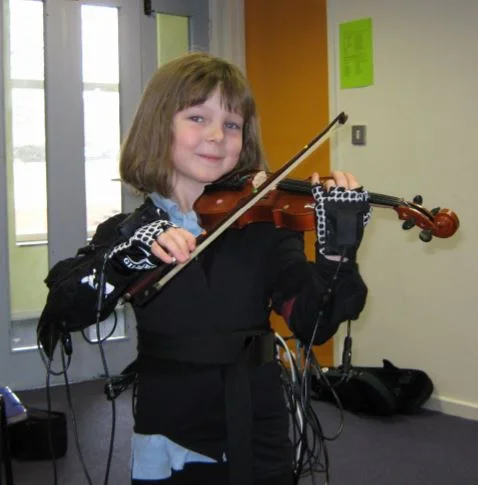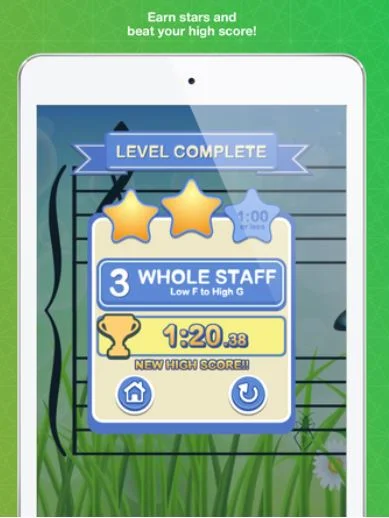One of the difficulties music teachers face is their ability to give regular feedback and to students. If a student is taking private music lessons they most likely meet with their instructor once a week, with the bulk of the student’s progress dependent on their daily, individual practice. Often students are unsure of how to use this time most effectively and may practice notes and rhythms incorrectly, thereby solidifying mistakes or bad habits. But now, with the increase in the pervasiveness of technology, and accessibility to apps on smartphones and tablets, there are many ways that technology can aid in assessing students’ progress, for both the teacher and the student. One such application of technology in both the private or group music lesson is drill and practice software, which can “provide a more persistent learning since it allows a drill and practice at desired level and desired amount” (Nart 80).
Apps
There are many apps that exist with the purpose of reinforcing musical concepts through practice activities and repeated drills, which also provide immediate feedback to the student allowing them to better gauge their own understanding of material. Many apps use basic gamification to increase engagement and students are encouraged to keep learning to progress from one level to the next. Noterush is a popular app to reinforce note reading that can be used as an alternative to flashcards. This can be a great tool to use in music lessons or for students to use at home. The app will display a note on the staff, which can be restricted to a specific range ahead of time, and provides immediate feedback using a microphone and sound detection technology to determine whether the student is playing the correct note. Other similar apps are Flashnote Derby, Note Perfect!, and Music Flash Class. There are also apps for supporting rhythm learning, such as Rhythm Lab, where students can get instant feedback after tapping a notated rhythm on the screen.
Figure 1. An achievement marker in the Noterush app (Noterush)
All these apps can be useful tools for a teacher to use in tracking a student’s progress from week to week. These tools can be integrated into weekly assignments and planned practice sessions, where teachers can give students a set goal to reach by the following lesson. Teachers can then view progress in the student’s app by checking the level they have achieved or by doing an in-lesson assessment of the student using the app in the next lesson. Furthermore, these apps can allow for greater parental involvement in the assessment process as they can monitor the game as the student is playing it to see how well they are understanding the material.
SmartMusic
A more sophisticated type of technology that is continually developing is the interactive music software called SmartMusic. This program is changing the way students practice and is useful as an assessment tool for both student and teacher. Teachers can assign specific music for the student to practice by directly uploading music, or by specifying scores that are already in the platform. Students can record themselves playing the piece directly through SmartMusic, which will follow the notated pitches and rhythms checking for errors. Any spots where they made an error will display while they are playing, thereby allowing for immediate assessment. There is also the option to send their recording directly to their teacher. Teachers can create individual exercises with a uniquely defined rubric which the student can complete and submit through the cloud for automatic grading. The program can also teach aural skills and tonal memory through activities where students hear a passage and play it back on their instrument by ear, and improvisation and understanding of chordal patterns. It is versatile and can aid in providing a well-rounded musical education experience for the student.
SmartMusic has many applications and has been used by both in-school music teachers and independent music teachers. Furthermore, it seems to influence the time spent in practice. Brian Nichols’ researched the impact of SmartMusic on student’s practice and determined that using the technology does not impact the students’ intrinsic motivation to practice but the length of time spent. Those in the study spent more time practicing than the control group. Nichols recommends adding a feature to the program that incorporates social media and might build student’s motivation to practice (Nichols 29). SmartMusic, as with similar technologies, is continuing to develop with new features and capabilities being added regularly. In the future there is great potential to use this as a tool to possibly increase student’s motivation while providing more accurate feedback.
Wearable Technology
Another less common technology that can aid in students’ practicing, and provide feedback on students’ technique and form is wearable technology. For example, a real-time feedback wearable jacket, called MusicJacket, can be used by violin students to improve their bowing and physical position. As the student is practicing, the jacket can sense if the arm position and bowing direction is correct and will send a vibrotactile signal in the form of a vibration to the student if not. This allows the student to immediately correct their posture, resulting in more constructive and healthy practice. There are many ways this could be implemented by the independent music teacher in the future for a variety of instruments, although at this point there are many barriers such as time required for set up and limited availability.
Fig. 2. A student learning violin using the MusicJacket (Linden 535) (See Buzzing to play: lessons learned from an in the wild study of real-time vibrotactile feedback)
Challenges and Efficacy:
One of the challenges of integrating any technology into an educational environment is ensuring that the technology directly assists in achieving the intended outcome. By focusing on technologies as a means of developing students’ personal assessment they can become more confident and accurate musicians. Another challenge can be the learning curve required of the music teacher. In order to implement any of these technologies into a lesson they must fully understand how to use the technology so that it does not take away from the time together, but rather heightens the learning experience.
When implemented successfully there are many benefits to integrating the aforementioned technologies into a lesson. They can target multiple learning styles, especially to the more visual or kinesthetic learners. They also can be an incredible motivation, which according to Mark Sharples is due to the immediate feedback and tracking consistency (Sharples 18). Furthermore, using technologies like SmartMusic can help to structure lessons and create more of a regular and routine practice session.
Application:
There are many ways in which institutions, from music schools to non-profits, can assist in the implementation of these technologies to enhance educational opportunities for their students. Through financial support more students can have access to these apps and programs in their lessons. Many teachers are hesitant to incorporate new technologies into their lessons because of lack of training. Institutions can support their teachers by providing training on how to integrate technology into their lesson plans.
Works Cited
Criswell, Chad. “Assessment Technologies and Tools for the Music Classroom.” SmartMusic. May 7, 2018. Accessed March 17, 2019. https://www.smartmusic.com/blog/assessment-technologies-music-classroom/
Heavner, Tracy. Teaching Instrumental Music Lessons Via the Internet.” International Journal of Arts & Sciences; Cumberland 4 (21): 307–13.
Linden, Janet van der, Rose Johnson, Jon Bird, Yvonne Rogers, and Erwin Schoonderwaldt. 2011. “Buzzing to Play: Lessons Learned from an in the Wild Study of Real-Time Vibrotactile Feedback.” In Proceedings of the 2011 Annual Conference on Human Factors in Computing Systems - CHI ’11, 533. Vancouver, BC, Canada: ACM Press. https://doi.org/10.1145/1978942.1979017.
Morin, Joy. “Music Apps.” Color In My Piano (blog). Accessed March 19, 2019. https://colorinmypiano.com/music-apps/.
Nart, Sevan. 2016. “Music Software in the Technology Integrated Music Education.” The Turkish Online Journal of Educational Technology 15 (2): 7.
Nichols, Brian Duane. “The Effect of SmartMusic on Student Practice.” (Doctor of Education in Teacher Leadership, Kennesaw State University, 2014) Accessed March 17, 2019. http://digitalcommons.kennesaw.edu/teachleaddoc_etd.
“Note Rush - Learn to Read Music and Play Piano, Keyboard, Saxophone, Flute, Violin and More!” Accessed March 17, 2019. https://www.noterushapp.com/.
Sharples, Mike. “Methods for Evaluating Mobile Learning.” Researching Mobile Learning: Frameworks, Tools and Research Designs (2009): 17-39. Accessed March 17, 2019. http://www.researchgate.net/profile/Mike_Sharples/publication/252110088_Methods_for_Evaluating_Mob ile_Learning/links/54995fcc0cf21eb3df60950f.pdf.
“Top 3 Most Innovative Rhythm Teaching Resources.” 2014. Creative Music Education (blog). August 22, 2014. https://timtopham.com/top-3-most-innovative-rhythm-teaching-resources/



